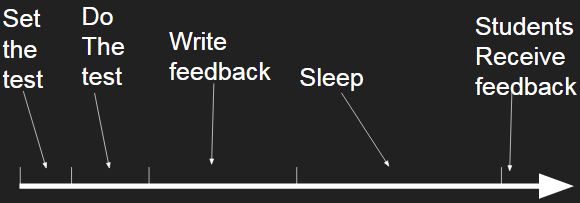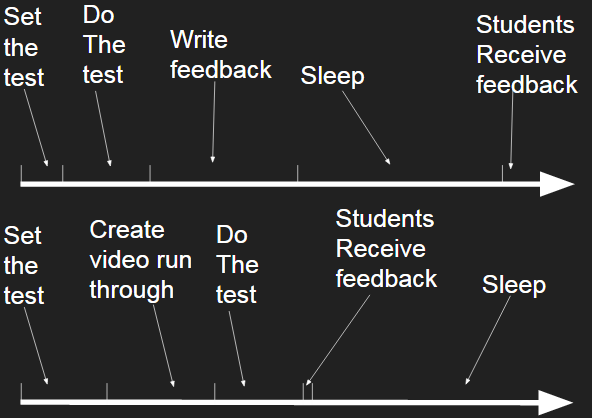I need more time.
I know you’ve said these words before. As a proud new dad, I’ve become obsessed with the concept of time.
But the truth is you can’t have more time.
Each day you receive 24 hours, or 1440 minutes, or 86400 seconds. No more, no less.
But what if I said you could manipulate time? Stretch it, stop it, speed it up or slow it down, transplant it from now to tomorrow. What if you could gift others your time, or others could gift it to you?

Technology makes all this possible.
Time Manipulation: An example
Let’s set a diagnostic test for our class.
Option A: To make setting this task very fast, I’m going to handwrite it onto a piece of paper and photocopy it 28 times. I hand out the diagnostic test in class and it takes the whole period to do. The bell goes and students file out, handing me their exams as they do. I take them home, give excellent written feedback and hand them back in class the next day.
On a timeline it looks like this.
Option B: I’ll create the diagnostic test, but this time in digital form. A self-marking quiz using software like google forms quizzes. I’ll also create a video of myself doing the test, narrating common errors as I do. The moment students complete their exams and hit “submit”, they will receive an email telling them which questions they got wrong. They will also receive a link to the instructional video and additional, similar questions they can practise.
Finally, let’s compare the two.
Time Manipulated
A few things have happened here. The workload in option A is heaviest after the diagnostic, when giving written feedback. It must be done, and fast, so that the students receive their feedback. In option B, technology has allowed the workload to be “shifted” to the start. This “front loading” of time means it can be done at the teachers leisure.
In option A, you are a slave to time. In option B, its master.
From the students’ point of view time has been drastically altered. In option A, students will be waiting at least 24 hours for feedback. In option B feedback is instantaneous. Here, time has been manipulated by the teacher for the benefit of the student.
Giving students the gift of time
Giving students more time to learn is the most precious gift you could give them. The best way to do it? As I so often find myself saying, the answer is a video.
If you record a video before class you are doing some amazing time manipulation. You are taking time from outside of the class (when you made the video) and moving it inside of the class. This “transplanted” time can be spent doing all of the things we know improve learning.
Not only that but you are also giving your students the power to manipulate time. Via video they can slow down, speed up, pause, rewind, fast forward and relive time. Giving students autonomy over how their time is spent in instruction is an incredibly powerful thing.
Master or Slave?
Next time you’re planning a lesson, consider time. Because you have a lot more control over it than you think.
How are you manipulating time using technology? I’d love to hear about it in the comments below.



Hi Joel,
Nice to know you’ve added Time Lord to your list of superpowers! Just in time feedback is truly what matters most to students because the brain is so receptive to adaptation while problem solving. Leaving that big gap of time is what often switches the learner into a fixed mindset when making a mistake, whereas immediate feedback helps the learner adapt and adjust to their errors much more easily. Out of interest, have you had feedback from students on how this process works for them?
Dr Strange rules (and it’s out on iTunes, woohoo!).